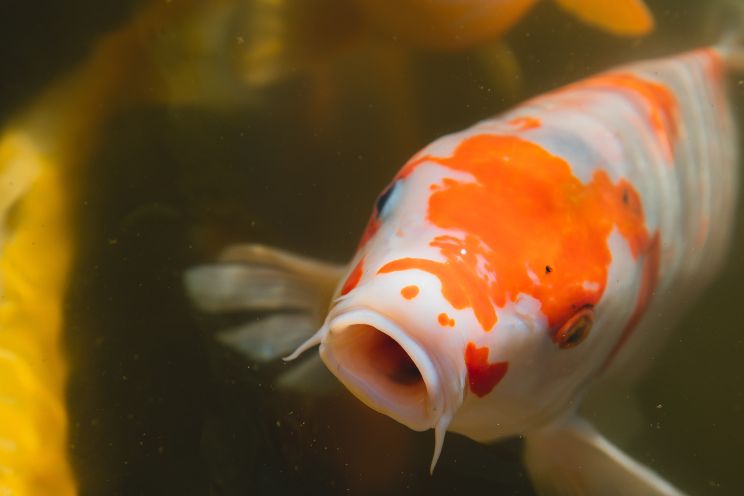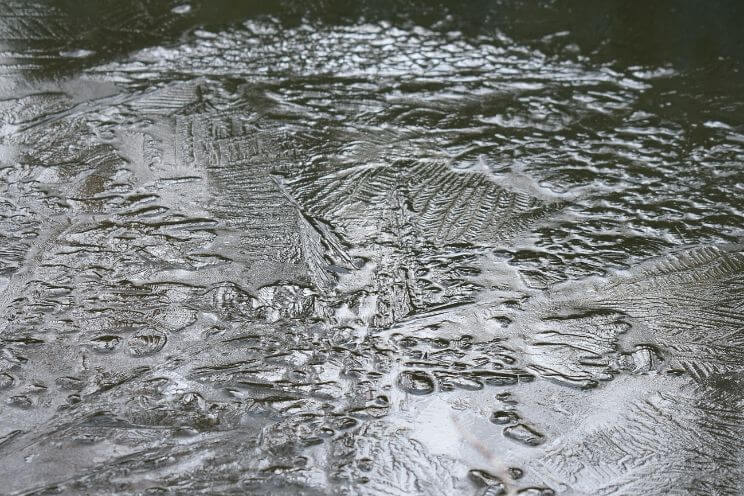You may be wondering if it is possible to move pond fish during winter. Is it a good idea? Are there complications I need to consider?
In this guide, we aim to discuss the factors that can affect moving Koi carp during winter, when it can be done and if it should be done.

Can you move fish in the winter?
Ideally, the latest time in the year you should be moving fish is early October. After this, the temperatures drop below 10 C / 50F frequently which is too cold for koi to adjust to quickly.
Below these temperatures, goldfish and koi enter a state called torpor, where their bodily processes slow down and they hibernate.
To enter hibernation takes a while; usually a couple of days to a week or more. Fish that are left throughout the year have a number of weeks to prepare themselves for winter.
A fish that has been brought from indoors to outdoors will not have this time to adjust and will have a temperature shock, which they can die from – they must be very gradually and slowly introduced.
As far as moving them from pond to pond during Winter, while we don’t recommend it, this can be done if the ponds are the same temperature.
But you need to minimise stress, as Koi become extra vulnerable to disease from stressing out during their torpid state.
When can you move koi?
Moving pond fish is best done around the warmer months of the year, late Spring, Summer and early Autumn are the most ideal times.
November is the absolute latest time of year to move koi carp as during the day it is usually lower than 10C / 50F and at night it can drop as low as 1C – 2C.
The earliest time to move Koi is around March, where daily temperatures are regularly above 10C.
However, early spring and late autumn are very unstable times of year in terms of temperature fluctuation, so be mindful when moving your fish. You may want to take extra measures to ensure their safety.
- Perhaps use pond covers during this time to prevent large temperature drops from wind and ice.
Temperature shock can cause fish to become ill and can be very serious. The sudden change can cause organs to fail, stop blood from flowing and can kill a fish very quickly if the temperature difference is severe.

What do you do with koi in the winter?
When winter rolls in, your koi will become dormant. They will be very inactive aside from swimming slowly around the bottom of the pond – they will not eat and may show no interest in you when you approach.
The best thing to do during winter is to leave them alone; feeding them will only cause harm as below 5C, the bacteria inside the carp’s stomach completely stops working. Anything given to them now will only sit in their stomach and rot until spring.
Any stress is amplified as the fish feel particularly vulnerable at this time, so keep handling to a minimum – this is why we don’t recommend moving fish in winter as stress plays a big factor in the loss of fish during winter.
The only things you should be doing with the Koi during winter, is making sure that the filtration is maintained, whether you decide to turn off your filters or not, making sure your equipment is still in good condition is important.
You also need to ensure that gaseous exchange is still possible if the pond freezes over, meaning you need to frequently break the ice to allow air to get to the water body, which allows the koi to breath.
If the ice sheet fully covers the pond, it can stop oxygen from dissolving from the atmosphere and the koi can suffocate.
Using an ice defrosting pond heater is a good way of ensuring there is a constant gap in the ice, from where fresh oxygen can dissolve into the pond water.

Is it safe to move fish while they are hibernating for the winter?
In short, we don’t suggest moving or handling hibernating fish if avoidable.
It can cause all types of problems, from high stress, shock and sickness to full immune system and organ failure, especially if the fish are moved to a completely different temperature.
Shocking a hibernating fish by moving it from a freezing cold pond to a warm tank will shock it out of torpor, which can kill the fish.
Never try to bring your fish out of torpor, it is a process that takes days to adjust out of and cannot be rushed.
Can koi fish survive winter in an outdoor pond?
Yes, so long as the pond is at least 3 ft deep and is insulated on the sides, your koi carp will be fine left outside over winter.
Just like goldfish, Koi are adapted to survive against freezing temperatures, and can actually live under sheets of ice for a number of months.
The only time Koi wouldn’t survive outdoors is if the pond becomes completely frozen, which happens if it is not insulated properly or is too shallow.
If the pond is raised and has poor insulation on the sides, ice will form on all sides as well as on top and can kill the fish.
If the pond is less than 3ft deep, then a particularly cold spell could result in the ice on top reaching down and chilling the koi to death.
However, as long as the pond is the right depth and is insulated, you don’t have much to worry about, your koi should survive perfectly fine all winter.
In fact, hibernating like this actually increases the lifespan of your koi, and they can live for many years longer than they normally would, if allowed to stay outdoors over winter.

Should I cover my pond in winter?
Covering your pond in winter can help prevent it from a few dangers.
The main thing covering your pond does, is blocks out wind, which can be surprisingly bitter in the dead of winter and can really chill an exposed pond.
Adding a cover also blocks out debris like dead leaves, which could rot in the pond and cause problems with pH and ammonia.
A cover can also stop predators like heron from attacking your koi while they are in a docile state.

Koi pond water temperature in Winter and feeding
Checking your temperature during autumn is very important as it can tell you a lot about what state your fish are in.
It also tells you what you should be feeding your fish at what time. For example, once the temperature drops below 10C / 50F, you should begin feeding your koi wheatgerm.
This is because below this temperature, protein is very hard to digest and so they need more fibrous foods instead, otherwise the protein rich food can cause digestive issues.
Later on around November, the temperatures will drop further and lie around 5C / 41F.
At this point, feeding your fish will cause more harm than good, as the food will rot and cause ammonia, or could be swallowed by your fish and cause bloat.
- From November through to late March, you should not feed your fish at all.
- From the months September to October, and March to April, feed your koi wheatgerm.
For the rest of the year you can feed all the normal varieties of food you give your koi, including all the high protein bloodworms, pellets etc.
